Can Forest Management Improve Water Retention Conservation Under Climate Change? A Case Study of the Republic of Korea
Abstract
1. Introduction
2. Materials and Methods
2.1. Study Area
2.2. Forest Dynamic Stand Growth Model
2.3. Forest Aboveground Water Yield Model
2.4. Forest Soil Belowground Water Storage Model
2.5. Data Preparation and Modification
3. Results
3.1. Forest Aboveground Water Yield
3.2. Forest Soil Belowground Water Storage
4. Discussion
5. Conclusions
Supplementary Materials
Author Contributions
Funding
Data Availability Statement
Acknowledgments
Conflicts of Interest
References
- Calvin, K.; Dasgupta, D.; Krinner, G.; Mukherji, A.; Thorne, P.W.; Trisos, C.; Romero, J.; Aldunce, P.; Barrett, K.; Blanco, G.; et al. IPCC, 2023: Climate Change 2023: Synthesis Report. Contribution of Working Groups I, II, and III to the Sixth Assessment Report of the Intergovernmental Panel on Climate; IPCC: Geneva, Switzerland, 2023; pp. 1–186. [Google Scholar]
- McNutt, M. Climate Change Impacts. Science (1979) 2013, 341, 435. [Google Scholar] [CrossRef]
- Bonan, G.B. Forests and Climate Change: Forcings, Feedbacks, and the Climate Benefits of Forests. Science 2008, 320, 1444–1449. [Google Scholar] [CrossRef] [PubMed]
- Kim, J.H.; Kim, R.H.; Youn, H.J.; Lee, S.W.; Choi, H.T.; Kim, J.J.; Park, C.R.; Kim, K.D. Valuation of Nonmarket Forest Re-sources. J. Korean Inst. For. Recreat. 2012, 16, 9–18. [Google Scholar]
- Korea Forest Service. Climate Change and Forests; Korea Forest Service: Daejeon, Republic of Korea, 2009. [Google Scholar]
- Kim, M.; Lee, W.K.; Choi, G.M.; Song, C.; Lim, C.H.; Moon, J.; Piao, D.; Kraxner, F.; Shvidenko, A.; Forsell, N. Modeling Stand-Level Mortality Based on Maximum Stem Number and Seasonal Temperature. For. Ecol. Manag. 2017, 386, 37–50. [Google Scholar] [CrossRef]
- Oh, S.U.; Kim, E.H.; Kim, K.M.; Kim, M.K. A Study on the Application of Successful Forest Greening Experience for Forest and Landscape Restoration: A Comparative Study of Two Koreas. Sustainability 2020, 12, 8712. [Google Scholar] [CrossRef]
- Kim, M.; Kraxner, F.; Son, Y.; Jeon, S.W.; Shvidenko, A.; Schepaschenko, D.; Ham, B.Y.; Lim, C.H.; Song, C.; Hong, M.; et al. Quantifying Impacts of National-Scale Afforestation on Carbon Budgets in South Korea from 1961 to 2014. Forests 2019, 10, 579. [Google Scholar] [CrossRef]
- Kim, E.S.; Jung, J.B.; Park, S. Analysis of Changes in Pine Forests According to Natural Forest Dynamics Using Time-Series NFI Data. J. Korean Soc. For. Sci. 2024, 113, 40–50. [Google Scholar] [CrossRef]
- Bae, J.S. Key Issues and Future Prospects of Forests, Forestry, and Mountain Villages in 2023; National Institute of Forest Science: Seoul, Republic of Korea, 2023. [Google Scholar]
- National Institute of Forest Science. Development of Large-Scale Forest Spatial Information-Based Methods for Forest Water Resource Assessment and Prediction; National Institute of Forest Science: Seoul, Republic of Korea, 2018. [Google Scholar]
- McNulty, S.; Steel, A.; Springgay, E.; Caldwell, B.; Shono, K.; Pess, G.; Funge-Smith, S.; Richards, W.; Ferraz, S.; Neary, D.; et al. FAO, 2021: Managing Forests for Water [Chapter 3]. In FAO, IUFRO and USDA. A Guide to Forest-Water Management; FAO: Rome, Italy, 2021; pp. 31–74. [Google Scholar] [CrossRef]
- National Institute of Forest Science. 20 Key Facts About Forest Water Resources; National Institute of Forest Science: Seoul, Republic of Korea, 2015; Available online: https://east.forest.go.kr/kfsweb/cop/bbs/selectBoardArticle.do;jsessionid=e7PJCSdVdCbPhzY2lKaBYX1Zb5WaNFIiQYQoVsnlcbLRSAttvpBoEM4yHeBebnyq.frswas02_servlet_engine5?nttId=3053426&bbsId=BBSMSTR_1008&pageUnit=10&pageIndex=36&searchtitle=title&searchcont=&searchkey=&searchwriter=&searchWrd=&ctgryLrcls=&ctgryMdcls=&ctgrySmcls=&ntcStartDt=&ntcEndDt=&mn=NKFS_02_15_01 (accessed on 1 April 2015).
- National Institute of Forest Science. Research Report on the Quantification of Public Functions of Forests; National Institute of Forest Science: Seoul, Republic of Korea, 2010; Available online: https://scienceon.kisti.re.kr/commons/util/originalView.do?cn=TRKO201200009611&dbt=TRKO&rn= (accessed on 1 April 2015).
- Li, Q.; Wei, X.; Zhang, M.; Liu, W.; Fan, H.; Zhou, G.; Giles-Hansen, K.; Liu, S.; Wang, Y. Forest Cover Change and Water Yield in Large Forested Watersheds: A Global Synthetic Assessment. Ecohydrology 2017, 10, e1838. [Google Scholar] [CrossRef]
- Ford, C.R.; Laseter, S.H.; Swank, W.T.; Vose, J.M. Can Forest Management Be Used to Sustain Water-Based Ecosystem Services in the Face of Climate Change? Ecol. Appl. 2011, 21, 2049–2067. [Google Scholar] [CrossRef]
- Mills-Novoa, M.; Liverman, D.M. Nationally Determined Contributions: Material Climate Commitments and Discursive Positioning in the NDCs. Wiley Interdiscip. Rev. Clim. Chang. 2019, 10, e589. [Google Scholar] [CrossRef]
- Pauw, W.P.; Klein, R.J.T.; Mbeva, K.; Dzebo, A.; Cassanmagnago, D.; Rudloff, A. Beyond Headline Mitigation Numbers: We Need More Transparent and Comparable NDCs to Achieve the Paris Agreement on Climate Change. Clim. Chang. 2018, 147, 23–29. [Google Scholar] [CrossRef]
- Moomaw, W.R.; Law, B.E.; Goetz, S.J. Focus on the Role of Forests and Soils in Meeting Climate Change Mitigation Goals: Summary. Environ. Res. Lett. 2020, 15, 045009. [Google Scholar] [CrossRef]
- Grassi, G.; House, J.; Dentener, F.; Federici, S.; den Elzen, M.; Penman, J. The key role of forests in meeting climate targets requires science for credible mitigation. Nat. Clim. Chang. 2017, 7, 220–226. [Google Scholar] [CrossRef]
- Kim, B.S.; Choi, J.S.; Lee, J.K.; Jung, N.Y.; Kim, T.H.; Student, G. Comparison of Effective Soil Depth Classification Methods Using Topographic Information. J. Korean Geogr. Soc. 2023, 22, 1–12. [Google Scholar] [CrossRef]
- Lee, W.K. Climate-Smart Forestry for the Climate Neutrality Era; The Korean Academy of Science and Technology: Seongnam, Republic of Korea, 2023. [Google Scholar]
- Korea Forest Service. Forestry Statistics Yearbook; Korea Forest Service: Daejeon, Republic of Korea, 2024. [Google Scholar]
- Lee, J.Y. Evaluation of the Historical Development of Forest Administration Paradigm Changes. J. Korean Policy Stud. 2013, 13, 261–279. [Google Scholar]
- Korea Forest Service. 2022 Forest Basic Statistics (Revised Version); Korea Forest Service: Daejeon, Republic of Korea, 2023. [Google Scholar]
- Piao, D.; Kim, M.; Choi, G.M.; Moon, J.; Yu, H.; Lee, W.K.; Wang, S.W.; Jeon, S.W.; Son, Y.; Son, Y.M.; et al. Development of an Integrated DBH Estimation Model Based on Stand and Climatic Conditions. Forests 2018, 9, 155. [Google Scholar] [CrossRef]
- Hong, M.; Song, C.; Kim, M.; Kim, J.; Lee, S.G.; Lim, C.H.; Cho, K.; Son, Y.; Lee, W.K. Application of Integrated Korean Forest Growth Dynamics Model to Meet NDC Target by Considering Forest Management Scenarios and Budget. Carbon Balance Manag. 2022, 17, 5. [Google Scholar] [CrossRef]
- Ko, Y.; Song, C.; Fellows, M.; Kim, M.; Hong, M.; Kurz, W.A.; Metsaranta, J.; Son, J.; Lee, W.K. Generic Carbon Budget Model for Assessing National Carbon Dynamics toward Carbon Neutrality: A Case Study of Republic of Korea. Forests 2024, 15, 877. [Google Scholar] [CrossRef]
- Son, Y.M.; Kim, R.H.; Lee, G.H.; Pyo, J.K.; Kim, S.W.; Hwang, J.S.; Lee, S.J.; Park, H. Carbon Emission Factors and Biomass Allometric Equations by Species in Korea; National Institute of Forest Science: Seoul, Republic of Korea, 2010. [Google Scholar]
- Tian, D.; Yan, W.; Chen, X.; Deng, X.; Peng, Y.; Kang, W.; Peng, C. Variation in Runoff with Age of Chinese Fir Plantations in Central South China. Hydrol. Process 2008, 22, 4870–4876. [Google Scholar] [CrossRef]
- Kim, M.; Kraxner, F.; Forsell, N.; Song, C.; Lee, W.K. Enhancing the Provisioning of Ecosystem Services in South Korea under Climate Change: The Benefits and Pitfalls of Current Forest Management Strategies. Reg. Environ. Chang. 2021, 21, 6. [Google Scholar] [CrossRef]
- Kim, M. Impact Assessment of Climate Change and Management Strategies on Carbon, Water, and Wood Products in Korean Forests; Korea University: Seoul, Republic of Korea, 2018. [Google Scholar]
- Song, H.S.; Lee, K.; Jun, E. A Study on Forest Conservation Charge Applying the Concept of Complete Restoration. Korea Spat. Plan. Rev. 2015, 85, 3–22. [Google Scholar] [CrossRef]
- Kim, J.H.; Lee, K.H.; Park, C.W.; Seo, J.W.; Son, Y.M.; Kim, K.H.; Youn, H.J.; Park, C.R.; Lee, S.W.; Oh, J.S. Nonmarket Valuation of Forest Resource in korea. J. Korean Inst. For. Recreation 2006, 10, 7–15. [Google Scholar]
- Jin, Y.; Jeong, S.; Jeong, S.; Lee, D. Assessment on the Forest Conservation Value Considering Forest Ecosystem Services—The Case of Gapyung-Gun. J. Environ. Impact Assess. 2015, 24, 420–431. [Google Scholar] [CrossRef]
- Kim, J.U.; Sang, J.; Kim, M.K.; Byun, Y.H.; Kim, D.H.; Kim, T.j. Future Climate Projection in South Korea using the High-Resolution SSP Scenarios based on Statistical Downscaling. J. Clim. Res. 2022, 17, 89–106. [Google Scholar] [CrossRef]
- Hong, M.; Song, C.; Kim, M.; Kim, J.; Roh, M.; Ko, Y.; Cho, K.; Son, Y.; Jeon, S.; Kraxner, F.; et al. Modeling-Based Risks Assessment and Management of Climate Change in South Korean Forests. Forests 2023, 14, 745. [Google Scholar] [CrossRef]
- Moon, G.H.; Yim, J.S.; Moon, N.H.; Shin, M.Y. Development of Ingrowth Models for Forest Types in South Korea. For. Sci. Technol. 2019, 15, 221–229. [Google Scholar] [CrossRef]
- Hong, S.Y.; Kim, L.H.; Choe, E.Y.; Jang, Y.S.; Hyeon, B.G.; Son, Y.G.; Ha, S.G.; Park, C.W.; Song, K.C.; Lee, Y.J.; et al. Soil Environmental Information System “Heuktoram”. Mag. Korean Soc. Agric. Eng. 2011, 53, 27–40. [Google Scholar]
- Hong, M.; Song, C.; Kim, M.; Kraxner, F.; Ko, Y.; Son, J.; Lee, W.K. Realizing Climate Resilient Development Pathways in Forestry: A Focus on Carbon Management in Republic of Korea. Environ. Impact Assess. Rev. 2025, 110, 107665. [Google Scholar] [CrossRef]
- Chun, J.; Shin, M.Y.; Kwon, T.; Lim, J.H.; Lee, Y.G.; Park, K.E.; Kim, T.U.; Sung, J. Predicting the Changes of Productive Areas for Major Tree Species Under Climate Change in Korea; National Institute of Forest Science: Seoul, Republic of Korea, 2014; pp. 1–230. [Google Scholar]
- Kim, C.G.; Kim, N.W. Assessment of Forest Vegetation Effects on Water Balance in a Watershed. J. Korea Water Resour. Assoc. 2004, 37, 737–744. [Google Scholar] [CrossRef]
- National Institute of Forest Science. Long-Term Outlook for Forest Resources, Forest Products, and Forest Services; National Institute of Forest Science: Seoul, Republic of Korea, 2023. [Google Scholar]
- Kim, G.S.; Lim, C.H.; Kim, S.J.; Lee, J.; Son, Y.; Lee, W.K. Effect of National-Scale Afforestation on Forest Water Supply and Soil Loss in South Korea, 1971–2010. Sustainability 2017, 9, 1017. [Google Scholar] [CrossRef]
- Ma, F.; Liu, Y.; Qi, Y.; Deng, N.; Xiang, H.; Qi, C.; Peng, P.; Jia, L.; Zhang, X. Tree Age Affects Carbon Sequestration Potential via Altering Soil Bacterial Community Composition and Function. Front Microbiol. 2024, 15, 1379409. [Google Scholar] [CrossRef] [PubMed]
- Zhu, X.; Si, J.; He, X.; Jia, B.; Zhou, D.; Wang, C.; Qin, J.; Liu, Z. Effects of Long-Term Afforestation on Soil Water and Carbon in the Alxa Plateau. Front Plant 2023, 14, 1273108. [Google Scholar] [CrossRef] [PubMed]
- Keleş, S. An Assessment of Hydrological Functions of Forest Ecosystems to Support Sustainable Forest Management. J. Sustain. For. 2019, 38, 305–326. [Google Scholar] [CrossRef]
- Zhao, J.; Feng, H.; Xu, T.; Xiao, J.; Guerrieri, R.; Liu, S.; Wu, X.; He, X.; He, X. Physiological and Environmental Control on Ecosystem Water Use Efficiency in Response to Drought across the Northern Hemisphere. Sci. Total Environ. 2021, 758, 143599. [Google Scholar] [CrossRef]
- Sun, G.; Wei, X.; Hao, L.; Sanchis, M.G.; Hou, Y.; Yousefpour, R.; Tang, R.; Zhang, Z. Forest Hydrology Modeling Tools for Watershed Management: A Review. For. Ecol. Manag. 2023, 530, 120755. [Google Scholar] [CrossRef]
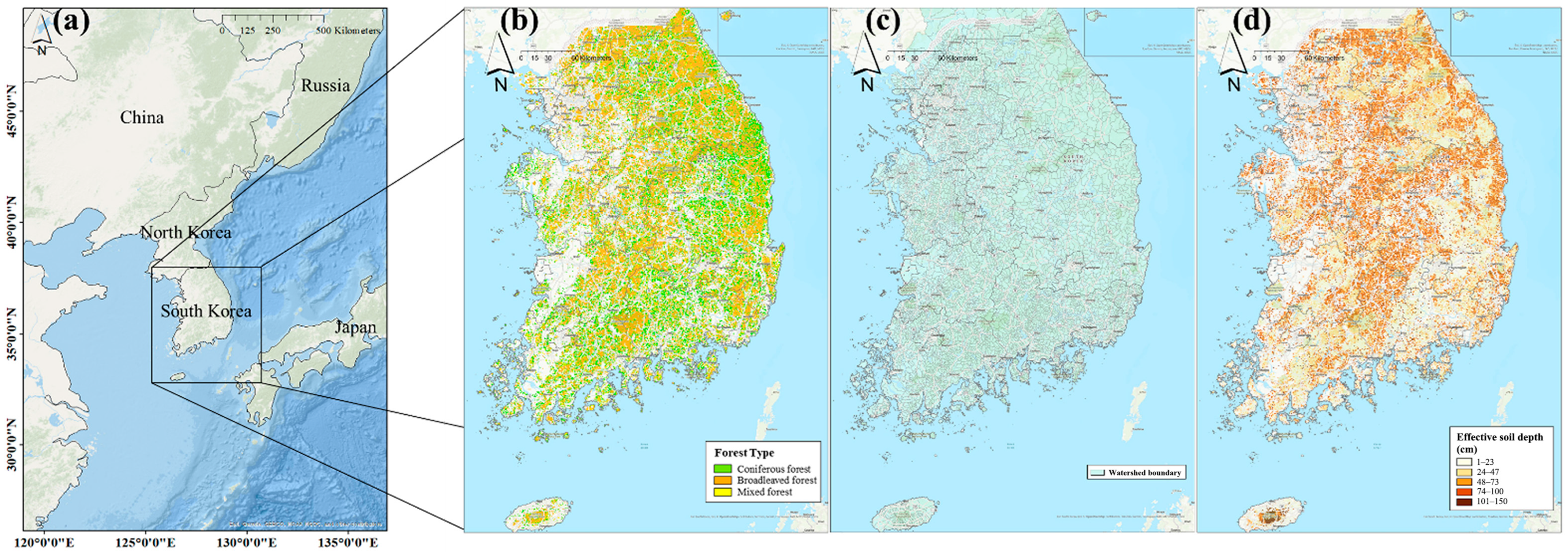
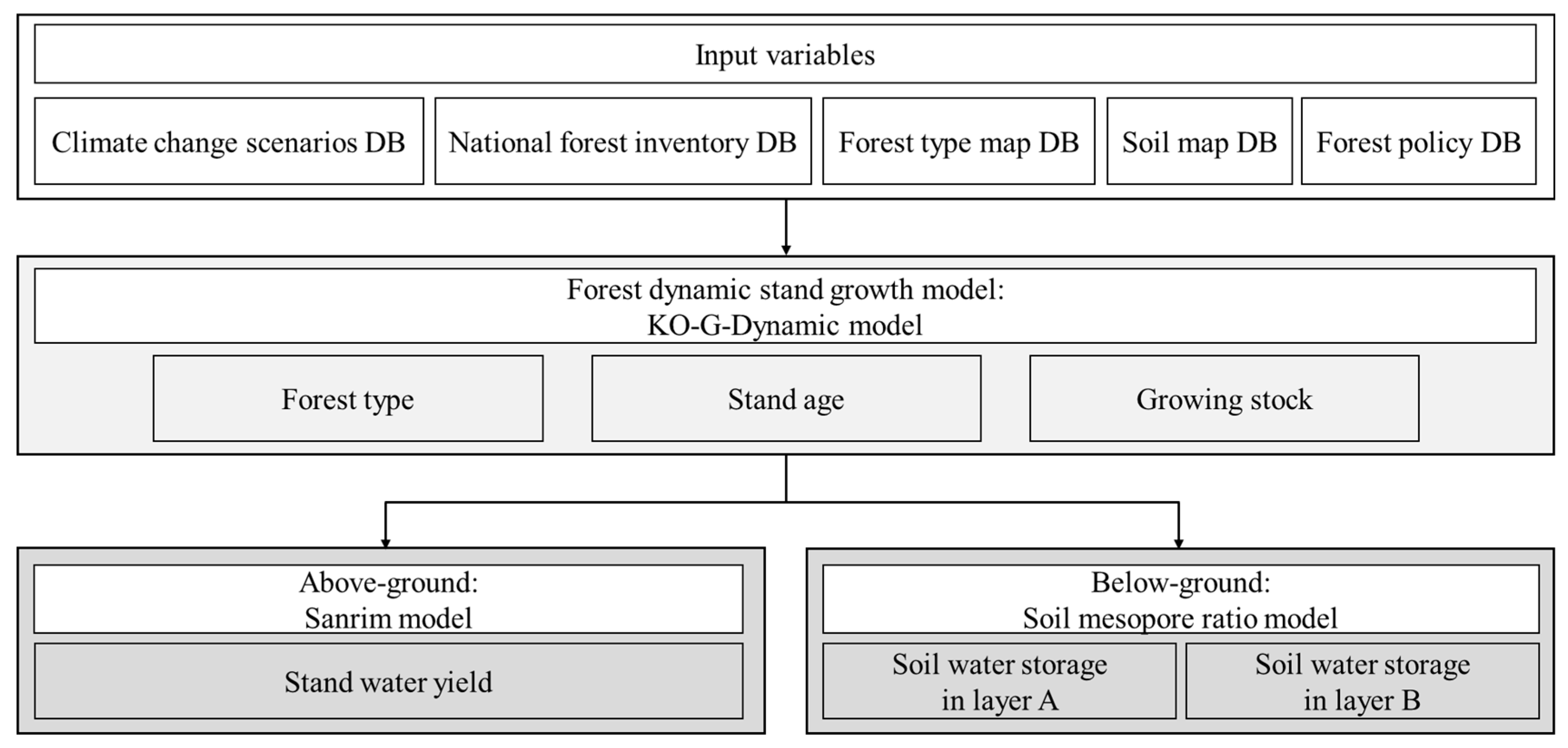
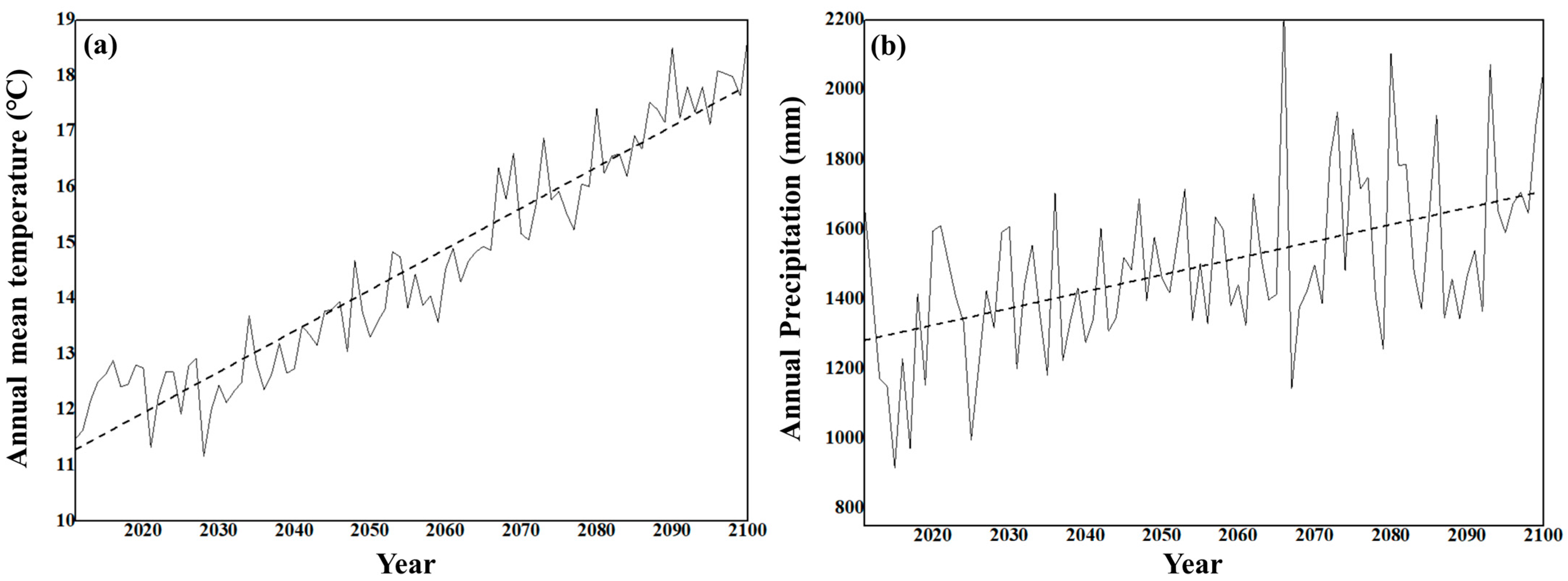
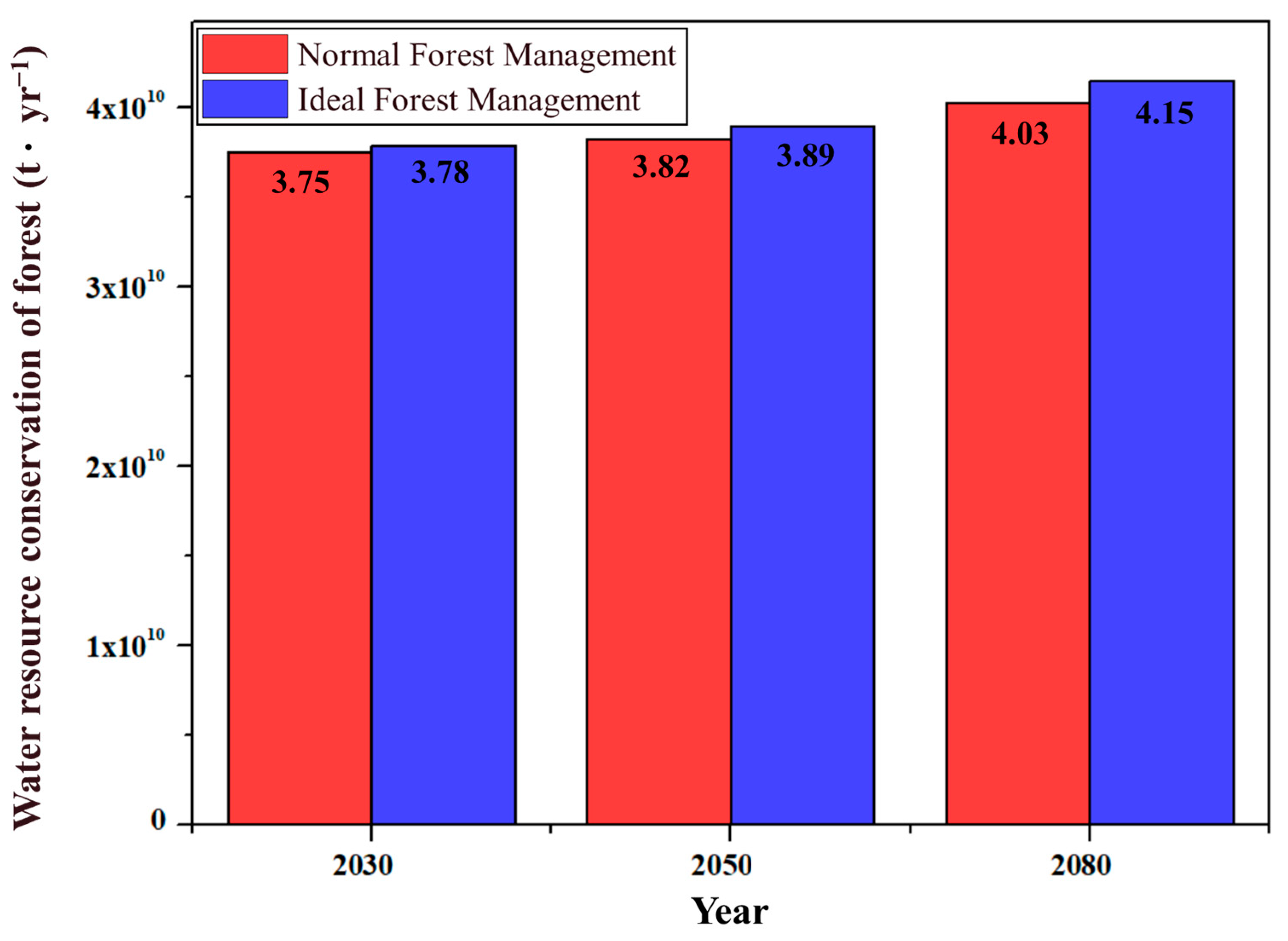
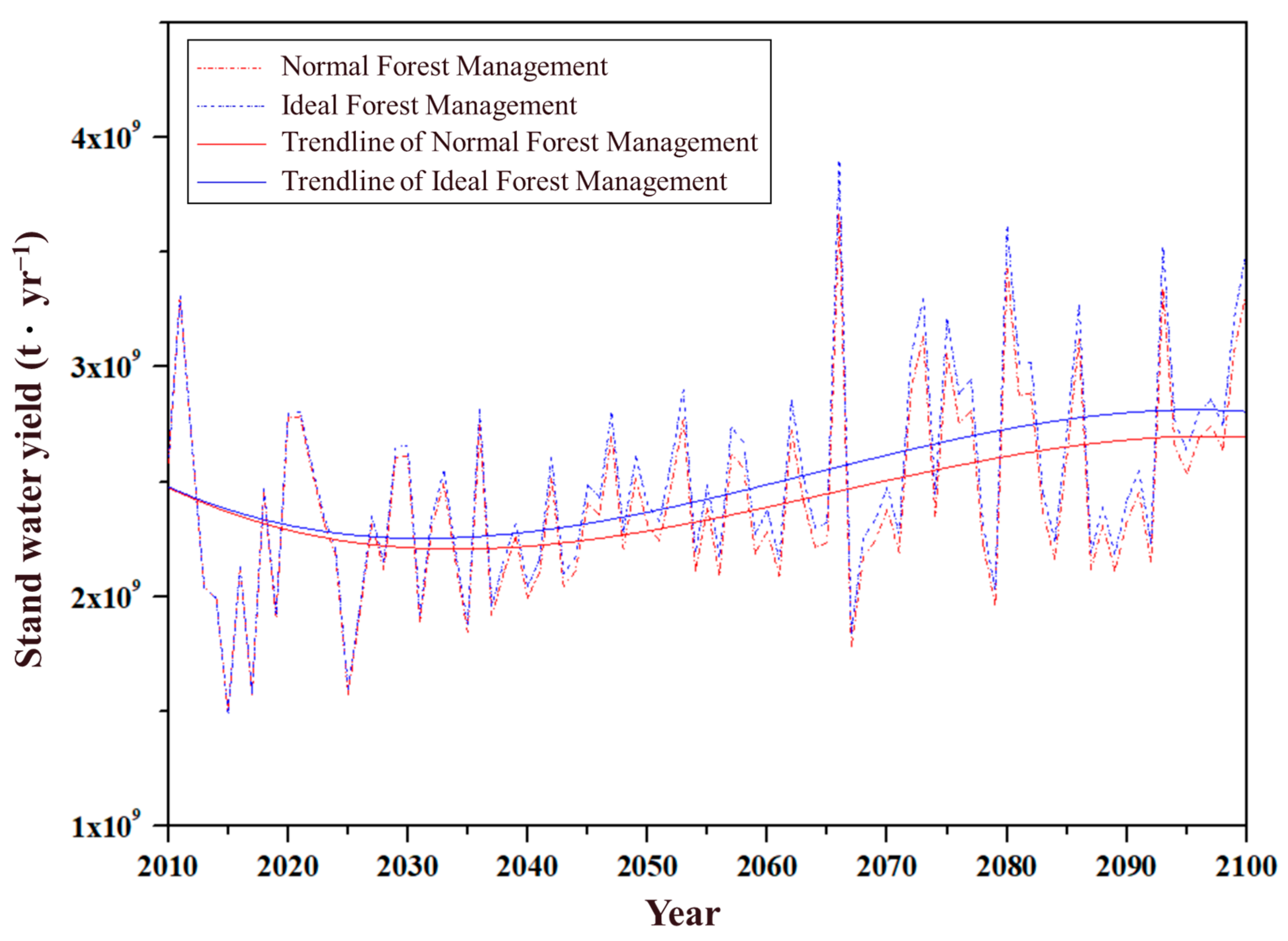
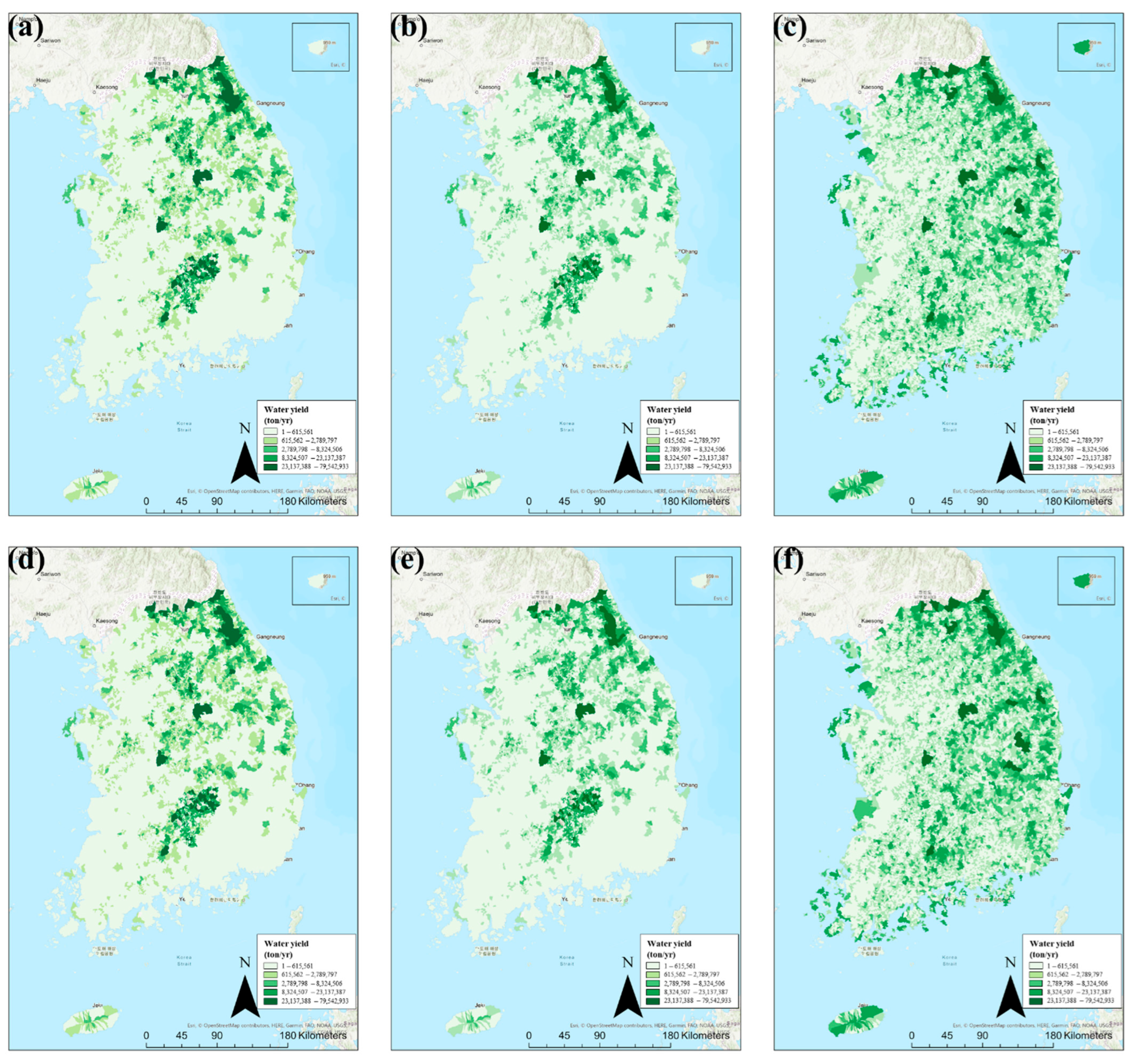

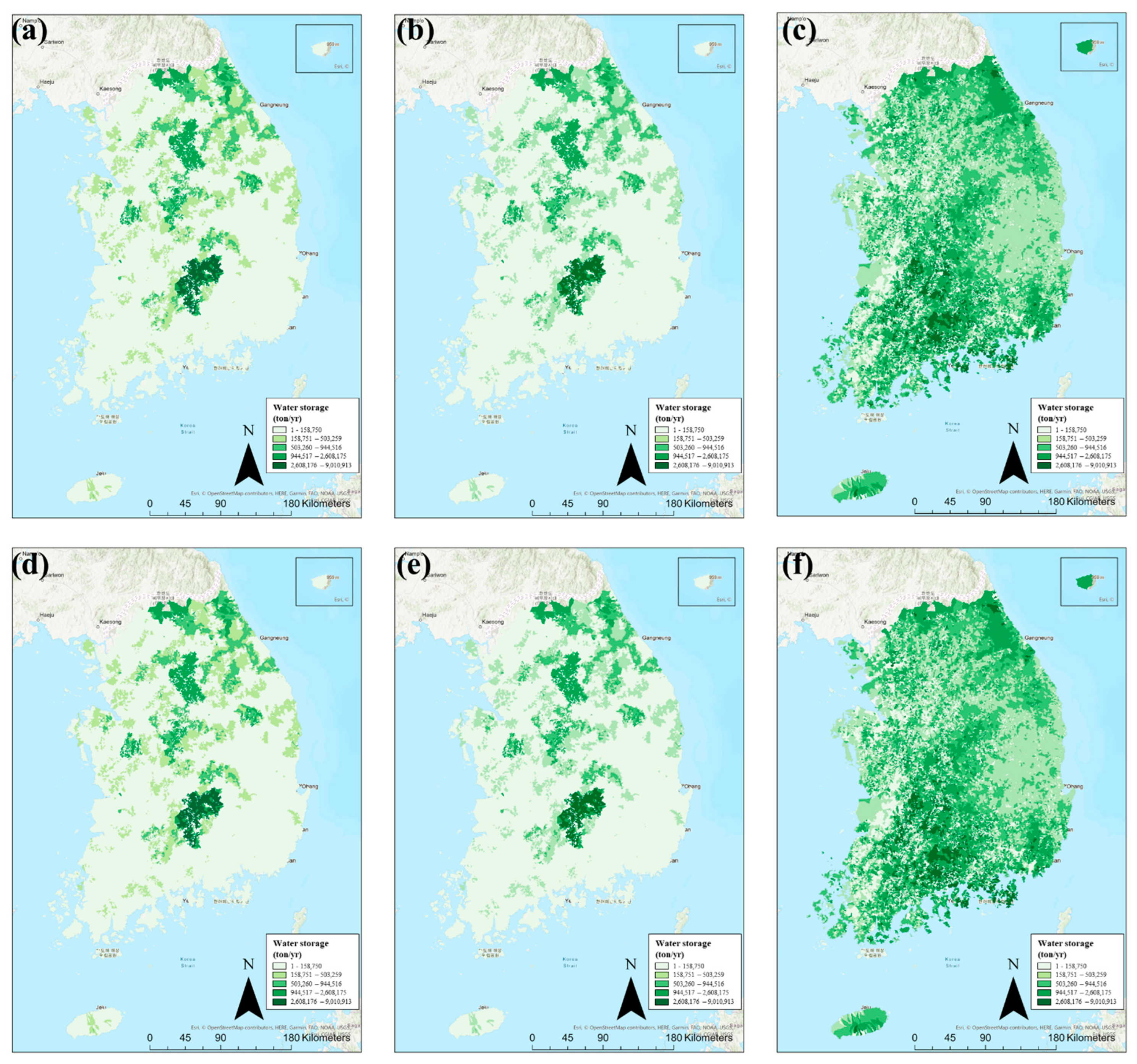
Disclaimer/Publisher’s Note: The statements, opinions and data contained in all publications are solely those of the individual author(s) and contributor(s) and not of MDPI and/or the editor(s). MDPI and/or the editor(s) disclaim responsibility for any injury to people or property resulting from any ideas, methods, instructions or products referred to in the content. |
© 2025 by the authors. Licensee MDPI, Basel, Switzerland. This article is an open access article distributed under the terms and conditions of the Creative Commons Attribution (CC BY) license (https://creativecommons.org/licenses/by/4.0/).
Share and Cite
Hong, M.; Ko, Y.; Lee, S.; Song, M.; Lee, W.-K. Can Forest Management Improve Water Retention Conservation Under Climate Change? A Case Study of the Republic of Korea. Forests 2025, 16, 862. https://doi.org/10.3390/f16050862
Hong M, Ko Y, Lee S, Song M, Lee W-K. Can Forest Management Improve Water Retention Conservation Under Climate Change? A Case Study of the Republic of Korea. Forests. 2025; 16(5):862. https://doi.org/10.3390/f16050862
Chicago/Turabian StyleHong, Mina, Youngjin Ko, Sujong Lee, Minkyung Song, and Woo-Kyun Lee. 2025. "Can Forest Management Improve Water Retention Conservation Under Climate Change? A Case Study of the Republic of Korea" Forests 16, no. 5: 862. https://doi.org/10.3390/f16050862
APA StyleHong, M., Ko, Y., Lee, S., Song, M., & Lee, W.-K. (2025). Can Forest Management Improve Water Retention Conservation Under Climate Change? A Case Study of the Republic of Korea. Forests, 16(5), 862. https://doi.org/10.3390/f16050862







